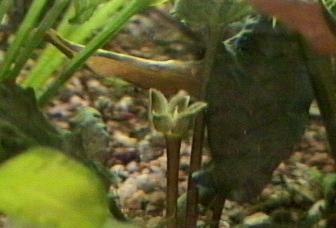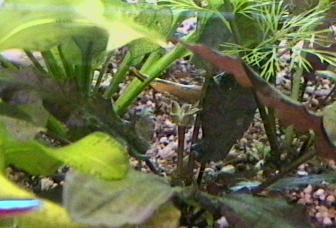
Crypt’s
have been familiar plants in the aquaria keeping hobby
for quite a while. Being categorized and brought over from Asia a
little over a century ago, these mysterious plants can assume many
different forms as the leaf shapes and colors which we see can be
radically altered based on environmental conditions.
There are quite a few distinctly different species which have been identified so far. Occasionally, a mistake will be made and what was believed to be two separate species will turn out to be simply two versions of the same species grown in very different conditions. For this reason the best way to identify Cryptocorynes is by their flower, or spathe, which is unique in every species.
The spathe is a bisexual flower in that it contains both male and
female parts. It takes the shape of a long slender tube or trumpet
,
with an opening in the top and occasionally a slight swelling at the
base or the kettle
where the female part resides.
Somewhere along the length of the trumpet the male pollen is located, it is believed that as an insect crawls through the trumpet it will pick up pollen which will then be carried down into the kettle of other crypts. Insect pollination is assumed based on the belief that the Cryptocoryne is self-sterile and will rarely boom while underwater. Occasionally when it does bloom underwater, the trumpet will reach up and out of the water creating a water tight tunnel accommodating a terrestrial insects path to the kettle.
Crypts are commonly propagated by vegetative means -- growing daughter plants off a primary plant or division of the rooting mass -- but there is very little information regarding true generative reproduction -- the mixing of genes between two plants via pollination and the creation of seeds.
In the summer of 1997 in a fairly newly established aquarium two crypts simultaneously produced fertile seeds which were germinated and grown into healthy little baby crypts. The species is believed to be Cryptocoryne wendtii wendtii, because the two different producing crypts were both bought as wendtii, and because they seem to conform to the documented description of wendtii--- although with the variability found among crypts we can only be sure when we catch it in bloom.
The aquarium was set-up approximately 4 months prior to the production of seeds. It is a 60-65 gallon custom made tank which is 20 inches deep. The tank was placed beside a large window facing North, and had four 20 watt aquarium grade bulbs on for a light duration of 8 hours 5 days a week, and 24 hours for the remaining two (lights left on over the weekend). I believe that getting two different plants blooming at the same time was due to the fact that there was enough sunlight to give seasonal queues.
The tank was filled with 50% old tank water from other tanks and 50%
new water. The substrate was a medium size (2-4mm average) natural
colored gravel which also contained bits of shell and other minerals
which dissolved into the water bringing the PH up to about 7.8 and the
hardness up to 80 ppm, from 40 ppm. The temperature was 25-26C and for
filtration a HOT Magnum was used with Penn Plax Cleanwater
instead
of activated carbon. Sera Florenette was put into the substrate
occasionally and water changes were done every 1-2 weeks, of 10%-25%
of the water.
Fish included in this tank were; 3 true Siamese algae eaters, 3+ Otocinclus; 24+ cardinal tetras (plus a few other tetras); and 6 juvenile angelfish.
The other plants in the tank were Water Sprite, Aponogeton crispus, Anubias nana, Anubias gigantia, Amazon sword, Microsorum (Java fern), duckweed, and Pennywort.

I first noticed what looked like a four petaled flower on what I
thought was a Crypt...however since crypts always send up an
unmistakable spathe, I tried to identify some other possible plant it
could be. I also tried to find out if there was some known crypt that
sent up such an un-spathe-like flower. Neither possibility turned out
to be the case when the flower
was finally and correctly identified
as being a seed pod.
I noticed the pod on July 10th, and took photo’s of it on the 14th. By
the 21st, some seeds had dropped out and started sending up
leaves. Some seeds still in the pod were also sending up leaves. At
this time I also located a second seed pod which developed a little
latter than the first one, and had 5 petals
. A month or so later
these two plants developed seeds again, and based on their
development, the two pods were not formed at the same time (maybe a
week off, as opposed to a few days off like the first time). The pods
contained 6 and 8 petals
this time, and the seeds were not fertile.
During the time I was germinating the seeds, I was fighting a loosing battle against Cyanobacteria (blue-green slime algae). I was concerned that changing too much of the water -in order to control the cyanobacteria -- could cause a meltdown of the delicate crypt sprouts. Amazingly, the seeds which had dropped down onto the algae didn’t seem to be affected by it. They sent down roots and put upleaves which were not covered by the slime.

The first seed pods each dropped about 12 seeds. I let some seeds
drop down in the tank, and two other batches I separated out to grow
differently. One batch I grew in 1 of water with the original
substrate and 2 20watt bulbs 15 away. These seedlings didn’t grow
well and eventually rotted away. The second batch I kept in the
original substrate and in the original tank inside a clear plastic
cup, with a second cup inverted and covering the first. I made sure
there was no visible algae in the cups, which I hoped would protect
the seedlings in case a fish decided they were salad
.
The seeds that just dropped and the ones in the cup all were fertile, and grew at a rate of about one new leaf and 3 mm length each week. After one month of growth the seeds in the cup were removed and planted in the original tank.
There are several interesting things about this propagation, primarily it is interesting that these crypts were never emersed, they were well under the water ever since the tank had been set-up 4 months previously. This means that either A) pollination took place underwater, and/or B) this particular Cryptocoryne is self-fertile (i.e. it can pollinate itself, or a plant produced as a vegetative offspring of itself). Another possibility suggested to me by a student of botany, is that I have an unusual mutation, which can happen when a plant has been vegetatively reproduced for several generations. Primarily these mutations simply weaken the existing plants genetic make-up, but occasionally a trait beneficial to the survival of the plant will occur.
In the case of A, pollination occurred via water currents, or possibly with the help of one of the algae eating fish which might have functioned much as a pollinating insect. A pollinating fish is quite unlikely, but at this point I want to include all the possibilities.
In the case of B, the fact that 2 different crypts bloomed and dropped fertile seeds at the exact same time is a doozy of a coincidence, and what happened was either that self-fertilization occurred in the spathe, or it was an incident of cleistogomy (the flower never opened, and as a result was self-fertilized).
It is unfortunate that I wasn’t watching this tank close enough to catch a possible blooming of the spathe, and that I do not know if the two propagating plants were vegetative offspring of the same parent plant or not. That information would point to a definite A, B, or possibly A and B, as well as giving a positive identification of the Cryptocoryne species. I hope to observe and document more of this particular plants reproduction in the future though, and may have an answer to these questions sometime soon!.
Heather Candelaria is now serving her second term on the GSAS board. She recently took over ownership of a local store...Stop by and say hi sometime.